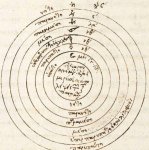My question was poorly worded. Here is what I'm getting at: the phthora for Pa is a circle with a line pointing down, while Ke is a circle with a line pointing up. Pa and Ke are closely related to each other in that they are the two bases for the first mode, depending on which production basis you use. That is, Ke used to be the basis of the first mode, but it has since moved to Pa. They are also the basis of a tetrachord with the same intervals. I thought that maybe Pa points down because it's the lower note of the pair, and Ke points up because it's the higher note of the pair.
The phthora for Ga is a circle with lines pointing both up and down. But Ga is also the median note (or mesos) between Pa and Ke, so it kind of makes sense that it would point both up and down. It's sort of "non-committal" because it's in-between.
Am I simply seeing patterns where there are none, like finding shapes in the clouds? Or are these patterns real? If so, what is the explanation for the rest of the phthorai?


